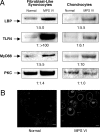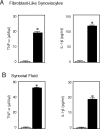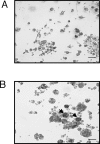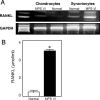Mechanism of glycosaminoglycan-mediated bone and joint disease: implications for the mucopolysaccharidoses and other connective tissue diseases
- PMID: 18079441
- PMCID: PMC2189614
- DOI: 10.2353/ajpath.2008.070564
Mechanism of glycosaminoglycan-mediated bone and joint disease: implications for the mucopolysaccharidoses and other connective tissue diseases
Abstract
We have previously shown that glycosaminoglycan (GAG) storage in animal models of the mucopolysaccharidoses (MPS) leads to inflammation and apoptosis within cartilage. We have now extended these findings to synovial tissue and further explored the mechanism underlying GAG-mediated disease. Analysis of MPS rats, cats, and/or dogs revealed that MPS synovial fibroblasts and fluid displayed elevated expression of numerous inflammatory molecules, including several proteins important for lipopolysaccharide signaling (eg, Toll-like receptor 4 and lipoprotein-binding protein). The expression of tumor necrosis factor, in particular, was elevated up to 50-fold, leading to up-regulation of the osteoclast survival factor, receptor activator of nuclear factor-kappaB ligand, and the appearance of multinucleated osteoclast-like cells in the MPS bone marrow. Treatment of normal synovial fibroblasts with GAGs also led to production of the prosurvival lipid sphingosine-1-phosphate, resulting in enhanced cell proliferation, consistent with the hyperplastic synovial tissue observed in MPS patients. In contrast, GAG treatment of normal chondrocytes led to production of the proapoptotic lipid ceramide, confirming the enhanced cell death we had previously observed in MPS cartilage. These findings have important implications for the pathogenesis and treatment of MPS and have further defined the mechanism of GAG-stimulated disease.
Figures







References
-
- Neufeld EF, Muenzer J. The Metabolic and Molecular Bases of Inherited Disease. New York: McGraw-Hill,; 2001:pp 3421–3452.
-
- Simonaro CM, Haskins ME, Schuchman EH. Articular chondrocytes from animals with a dermatan sulfate storage disease undergo a high rate of apoptosis and release nitric oxide and inflammatory cytokines: a possible mechanism underlying degenerative joint disease in the mucopolysaccharidoses. Lab Invest. 2001;81:1319–1328. - PubMed
-
- Simonaro CM, D’Angelo M, Haskins ME, Schuchman EH. Joint and bone disease in mucopolysaccharidoses VI and VII: identification of new therapeutic targets and biomarkers using animal models. Pediatr Res. 2005;57:701–707. - PubMed
-
- De Vries-Bouwstra JK, Goekoop-Ruiterman YP, Wesoly J, Hulsmans HJ, de Craen AJ, Breedveld FC, Dijkmans BA, Allaart CF, Huizinga TW: Ex vivo IL1 receptor antagonist production upon LPS stimulation is associated with development of RA and with greater progression of joint damage. Ann Rheum Dis 2007, Jan 12:[Epub ahead of print] - PMC - PubMed
-
- Goldring SR. Pathogenesis of bone erosions in rheumatoid arthritis. Curr Opin Rheumatol. 2002;4:406–410. - PubMed
Publication types
MeSH terms
Substances
Grants and funding
LinkOut - more resources
Full Text Sources
Other Literature Sources
Medical
Miscellaneous

